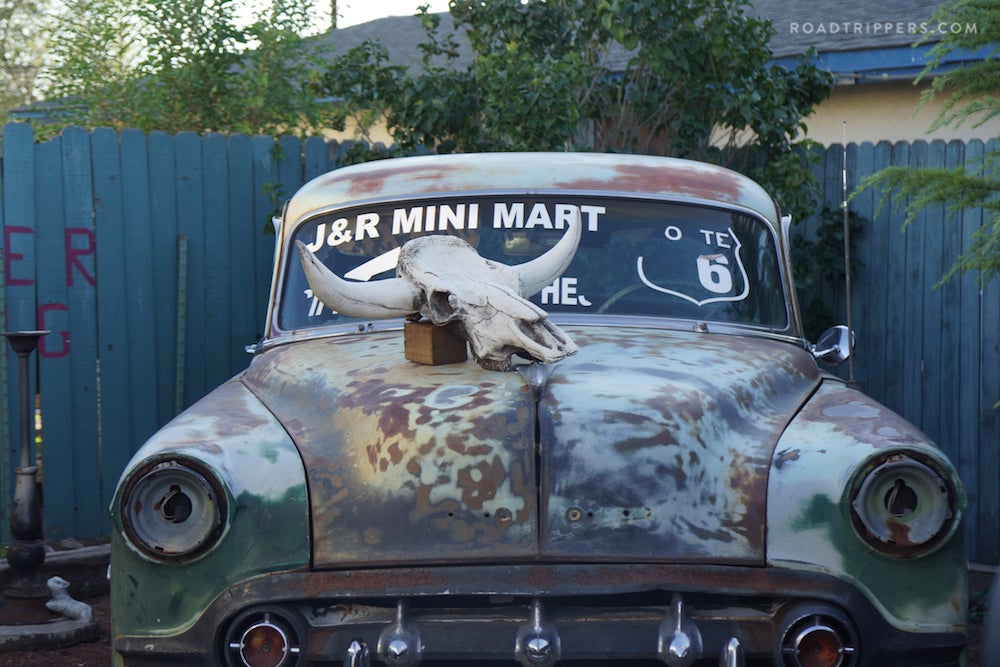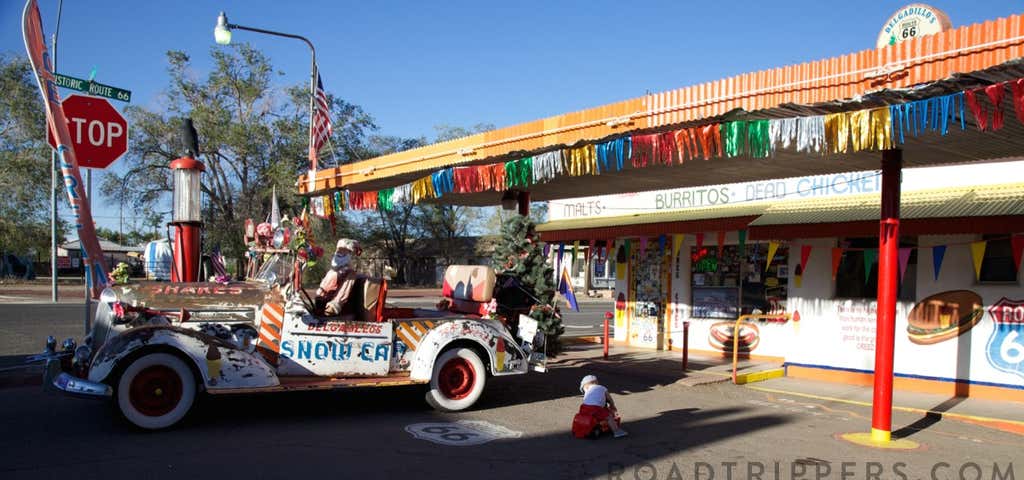Seligman is the little town that could. At just 6.4 square miles, and boasting a population of only 456, it's become a legendary Route 66 town, welcoming multitudes of visitors from around the world every year. And, seriously, when you drive through the town it feels like you've been transported back in time. Seligman's Main Street is lined with historic locally-owned businesses that, against all odds, have withstood the test of time.


Photo Credit: Roadtrippers


Photo Credit: Roadtrippers
Seligman is located in the heart of the northern Arizona high desert. It's a beautiful but unforgiving landscape. Seligman occupies a very cozy enclave surrounded by mountains in the east, desert in the west, and the Grand Canyon to the north. Originally, the area was the homeland of the Havasupai peoples, and, in fact, Seligman was originally a Havasupai settlement. The town was located along the historic Beale's Wagon Road, and was a stage stop along the Mojave Road. You could say Seligman was always a popular travelers' pitstop.


Photo Credit: Roadtrippers
Seligman, Arizona proper was founded in 1895 when the Peavine Railroad rolled through the town, making it the commercial epicenter of Northern Yavapai County. During the early 20th century, the Old Trails Highway, arguably America's first transcontinental road, went right through Seligman. Then, with the establishment of Route 66 in 1926, Seligman became a very popular spot for cross-country roadtrippers. However, after 1933, Route 66 bypassed Seligman's Main Street and the route was relegated to just Chino Street. It was recorded that over 500,000 out-of-state cars passed through the Arizona portion of Route 66 in 1937. World War II would disrupt road travel for a time, but only to see it come back with a vengeance after 1945, when returning servicemen and economic success drew more and more people to the Mother Road, with Route 66 being a premiere tourist destination. Neon signs, massive fiberglass roadside statues and exciting signage (Tucumcari Tonite!) lured road travelers to visiting towns along the route. Sadly, in 1978 I-40 opened up and towns like Seligman were bypassed in favor of faster interstate travel. Route 66's heyday was over.


Photo Credit: Roadtrippers
But, the Seligman Commercial Historic District refused to give up. Unlike some other towns along historic Route 66, which over the years have seen countless businesses shutter, Seligman fought back. The town retained its historic charm, working hard to maintain the early 20th century buildings that line Main Street, Railroad Avenue and Chino Street. Rather than let businesses go under, buildings go abandoned, and historic structures get demolished, they preserved what they could. Visitors today can still experience what life at least looked like back in the day, and enjoy roadside architectural style that's so unique to towns along Route 66. And throughout the town you'll see old-timey cars parked in front of businesses... these make for great photo ops. Also, if a lot of things start to look familiar in town, it might be because it was the main inspiration for the animated movie "Cars".
The largest motel in Seligman is the Stagecoach 66 Motel. It's got killer neon out front, a few themed rooms (one is inspired by "Cars"!), an onsite pizza joint with a bar and pool table, plus modern amenities like wifi and morning coffee and pastries. Even if you don't stay the night, snap a picture with the sign and chat up the locals in the bar over a cold beer. It's a great little place!
When Juan Delgadillo and his wife Mary opened the Snow Cap Drive-In on Route 66 in Seligman, AZ back in 1953, they probably didn’t anticipate it becoming a worldwide tourist attraction and enduring symbol of Route 66. Today, however, over 60 years later, the Delgadillos Snow Cap Drive-in is one of the most sought-out Route 66 destinations. The Snow Cap started humbly… built from scrap lumber from the Santa Fe railroad yard, Juan and his father and brothers made the now-iconic drive-in on an absolute shoe-string budget.
To attract travelers, Delgadillo took a 1936 Chevy and cut the top off and decorated it with every weird paint color and doodad he could find, even putting a Christmas tree in the back. The plan worked as today it’s still one of the most photographed pieces of Route 66 Americana. Juan Delgadillo’s own quirky and fun personality shines through in many parts of the Snow Cap like the menu that still features, “Dead Chicken,” dummy door knobs on the doors, funny signs, and lots of old rusty cars.
Despite passing away in 2004 at the age of 88, Juan’s style of interacting with his thousands of tourist visitors still lives on today. Known for bantering back and forth with his customers, Juan would often joke, “Do you want cheese on that cheeseburger?” His playful attitude shines through from the exterior to the interior to the service, even years after he passed away.
The Snow Cap, however, isn’t the only iconic Route 66 location in the Delgadillo family. Juan’s brother, Angel, made his mark on the Mother Road with his barber shop (now gift store). Angel, affectionately known as the “guardian angel” of Route 66, founded the Historic Route 66 Association of Arizona in 1987, a move that would quickly be imitated in other states with portions of Route 66. Juan and Angel may just be the Godfathers of today’s Route 66, helping keep the road alive and helping to keep travelers supporting these small towns that once flourished along the Mother Road.
Angel and Juan are regarded in such high esteem that when Disney/Pixar’s John Lasseter wanted to learn more about Route 66 for his upcoming movie, "Cars", he went to Angel for a history lesson. The friendly barber told the tragic tale of how traffic all but dried up after I-40 opened. Both brothers are listed in the credits to "Cars", and if you stop by Angel’s Barbershop (which you should) you’ll see a signed Toy Story sketch hanging on the wall as a thank you for Angel’s efforts. (Buzz and Woody are featured because the characters for "Cars" were still in development)
The Route 66 Road Runner is little pit stop that was opened fairly recently as a way to preserve the old Olsen’s Chevrolet dealership and garage building originally built in 1936. It features a classic adobe look and original redwood beams! The souvenir shop sells the expected Route 66 kitsch, but they also make an effort to offer distinctive wares as well, including locally-crafted Native jewelry. The restaurant serves up snacks and to-go grub, like ice cream, espresso, and breakfast burritos, along with sandwiches, burgers, hot dogs, and booze. They use a greaseless frying method and offers salads, which is notable. You don't realize how fattening a trip down Route 66 can be until you try and stop at every classic diner for burgers and fries along the way!
The Black Cat Bar has been in existence in some form since the early 1900s, keeping locals liquored up and happy. Today, it remains a no-frills, cash-only, totally down-to-earth joint where you can enjoy a stiff drink and a great night hanging out with the warm and welcoming locals. Play pool with cowboys and locals, or just enjoy a drink on the patio before retiring to your motel for the evening. This place is true-blue Seligman to the core.
The Historic Seligman Sundries is located in one of the town's oldest buildings, which dates back to 1906. It's utterly adorable and has a long history as a dance hall, a theater, a trading post, and a soda fountain. It was refurbished in 2005, and a lot of the signs that hang in the joint are authentic vintage artifacts uncovered during the renovations. You can still sit at the counter and order soda fountain favorites, and they've also added a great coffee bar (in case you need some fuel for the road) and sell little tchotchkes. They also have vintage cars out front as well, so grab a photo before you hit the road again!
Another great motel with another great neon sign! The Historic Route 66 Motel is a little smaller, but it still feels like something right out of the 1950s... that authentic motor lodge feel is hard to get right, since you have to balance between keeping the old-school charm while still keeping things modern and up-to-date, but this place nails it.
The Roadkill Cafe sets itself apart from other retro diners on the Route by being totally and ridiculously strange. The menu features dishes like Bad-Brake Steak, Fender Tenders, Caddie Grilled Patty, Splatter Platter, Swirl of Squirrel, Big Bagged Stag, Highway Hash... you get the idea. Around back is the O.K. Saloon, which features tons of Wild West memorabilia paying tribute to Arizona's rollickin' past.
As far as photo ops in Seligman go, The Rusty Bolt is easily the most insane. Old storefronts are lined with signs and topped with mannequins in ridiculous costumes and poses. Humorous little jokes and endless weird things to pose with can be found outside, and wacky employees and cute souvenirs are found within.


Photo Credit: Roadtrippers
What makes Seligman such a tough cookie of a town is that, unlike so many other railroad towns that were simply abandoned and forgotten with the rise of the interstate highway system and alternative transportation modes, the locals in Seligman didn't hesitate to embrace the town's Route 66 history. The shops and cafes they have preserved and opened are completely authentic. And, if you think about it, the authenticity is what makes Route 66 so alluring and enticing. The intoxicating nostalgia of driving down a small town's Main Street, and pulling over to enjoy a homecooked meal in a friendly, but unique place... that's why Route 66 has become so iconic, and why Seligman has not only survived, but thrived.
Roadtrippers
Roadtrippers helps you find the most epic destinations and detours—from roadside attractions to natural wonders and beyond.
Explore More Trip Guides
Family-friendly Phoenix attractions for visitors of all ages
- 9 Places
- 02:57
- 131 mi
Ancient history and modern mysteries in the Sonoran Desert
- 6 Places
- 04:32
- 229 mi











